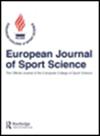High-intensity interval neuromuscular training promotes exercise behavioral regulation, adherence and weight loss in inactive obese women
IF 3
3区 医学
Q2 SPORT SCIENCES
引用次数: 28
Abstract
Abstract It is unclear how high-intensity, interval-type nontraditional exercise training programmes can be feasible and effective options for inactive obese individuals. This randomized controlled trial investigated the hypothesis that a 10-month high-intensity, interval-type neuromuscular training programme (DoIT) with adjunct portable modalities, performed in a small-group setting, induces improvements in psychological well-being, subjective vitality and exercise behavioural regulations in obese women. Associations between adherence, psychological and physiological indicators were also investigated. Forty-nine previously inactive obese females (36.4 ± 4.4 yrs) were randomly assigned to three groups (control; N = 21, 10-month training; N = 14, or 5-month training plus 5 month-detraining; N = 14). DoIT was a supervised, progressive, and time-efficient (<30 min) programme that used 10–12 functional/neuromotor exercises and prescribed work and rest time intervals (20–40 sec) in a circuit fashion (1–3 rounds) for 10 months. Questionnaires were used to measure psychological distress, subjective vitality, and behavioural regulations in exercise at pre-, mid-, and post-intervention. The 10-month training reduced psychological distress (72%, p = 0.001), external regulation (75%, p = 0.011) and increased vitality (53%, p = 0.001), introjected regulation (63%, p = 0.001), intrinsic regulation (33%, p = 0.004), and identified regulation (88%, p = 0.001). A moderate to strong positive relationship was found between adherence rate and identified regulation scores (r = 0.59, p = 0.001) and between VO2peak and identified regulation scores (r = 0.59, p = 0.001). A mild dissociation between exercise intensity and perceived exertion was also observed. Our novel findings suggest that a 10-month implementation of a high-intensity interval neuromuscular training programme promotes positive psychological adaptations provoking exercise behavioural regulation and adherence while inducing weight loss in inactive obese women.高强度间歇神经肌肉训练促进运动行为调节,坚持和减肥不活跃的肥胖妇女
目前尚不清楚高强度、间歇类型的非传统运动训练计划对不活跃的肥胖个体是否可行和有效。这项随机对照试验调查了一个假设,即在小群体环境中进行为期10个月的高强度间歇型神经肌肉训练计划(DoIT),并辅以便携式模式,可改善肥胖女性的心理健康、主观活力和运动行为调节。还调查了依从性、心理和生理指标之间的关系。49名既往无运动的肥胖女性(36.4±4.4岁)随机分为三组(对照组;N = 21, 10个月训练;N = 14,或5个月的培训加5个月的去培训;n = 14)。DoIT是一个有监督的、渐进的、时间效率(<30分钟)的项目,使用10 - 12个功能/神经运动练习和规定的工作和休息时间间隔(20-40秒),以循环方式(1-3轮)持续10个月。在干预前、干预中和干预后,采用问卷调查的方法测量心理困扰、主观活力和运动行为规范。10个月的训练减少了心理困扰(72%,p = 0.001)、外部调节(75%,p = 0.011)和活力(53%,p = 0.001)、内注入调节(63%,p = 0.001)、内在调节(33%,p = 0.004)和识别调节(88%,p = 0.001)。依从率与识别调节评分(r = 0.59, p = 0.001)、VO2peak与识别调节评分(r = 0.59, p = 0.001)呈中至强正相关。在运动强度和感觉劳累之间也观察到轻微的分离。我们的新发现表明,10个月的高强度间歇神经肌肉训练计划可以促进积极的心理适应,激发运动行为调节和坚持,同时诱导不活跃的肥胖女性减肥。
本文章由计算机程序翻译,如有差异,请以英文原文为准。
求助全文
约1分钟内获得全文
求助全文
来源期刊
CiteScore
6.60
自引率
3.10%
发文量
153
审稿时长
6-12 weeks
期刊介绍:
The European Journal of Sport Science (EJSS) is the official Medline- and Thomson Reuters-listed journal of the European College of Sport Science. The editorial policy of the Journal pursues the multi-disciplinary aims of the College: to promote the highest standards of scientific study and scholarship in respect of the following fields: (a) Applied Sport Sciences; (b) Biomechanics and Motor Control; c) Physiology and Nutrition; (d) Psychology, Social Sciences and Humanities and (e) Sports and Exercise Medicine and Health.

 求助内容:
求助内容: 应助结果提醒方式:
应助结果提醒方式:


